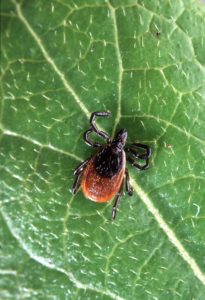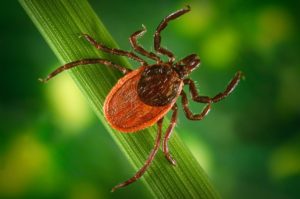18 December 2019
Climate change driving expansion of Lyme disease in the US
Posted by Lauren Lipuma
By Lara G. Streiff
Warmer winter temperatures are leading to an increase in cases of Lyme disease in the United States, according to new research.
A new study finds increasing average winter temperatures are driving up reported Lyme disease cases in the Northeast and Midwest, especially near the outer limits of tick habitats where warmer winters boost tick survival rates and ability to find hosts. Public health officials are even seeing the disease spread to parts of Canada, in areas where it has never been seen before.
“There’s a lot of prior evidence that climate, in particular temperature and moisture conditions, affect different parts of the lifecycle of the tick that transmits Lyme disease,” said Lisa Couper, an ecologist at Stanford University who presented the work last week at the 2019 American Geophysical Union Fall Meeting in San Francisco. “But what is less clear is how that actually translates to effects on cases of Lyme disease.”
Lyme disease is a bacterial infection that presents much like the flu and is transmitted by a tick bite. Headaches, stiffness, joint-pain and a tell-tale bulls-eye rash are just some of the unpleasant symptoms caused by a Lyme-infected black-legged tick. These tiny transmitters are approximately the size of a sesame seed as adults, though according to the Centers for Disease Control and Prevention, most people who contract the disease are infected by an immature teenage tick the size of a poppy seed.
Lyme disease cases have increased over the past several decades, but scientists are unsure what is driving this, and whether climate change is a factor. It is evident that climate change is drying out summers, lowering average winter temperatures and increasing spring showers in parts of the U.S. These changes can affect ticks by expanding their habitats, increasing their survival rates and shifting their strategies for finding hosts.
In the new study, Couper looked into how closely climate variations have influenced Lyme disease cases over the past two decades across seven regions in the continental U.S. She employed statistical analysis to separate the effects of climate change from non-climate related factors that might also cause increasing rates of the disease.
The results show warmer winter temperatures were an important factor in the increase in Lyme disease cases, though increasing spring rains and dry summers were not. Higher spring precipitation did result in fewer cases of Lyme disease in the Northeast and Midwest, but Couper mostly attributes this to people being less likely to go outside and pick up a tick, rather than climate effects on tick ecology.

Black-legged tick, also known as the deer tick (ixodes scapularis) on a leaf.
Credit: Scott Bauer/U.S. Department of Agriculture.
Ticks can be sensitive to drying out, so hot dry days, especially in the Southwest, could also impact Lyme disease cases. However, instead of hurting tick survival rates and subsequently lowering reported infections, ticks simply seem to have adapted to drier conditions by shifting strategies for finding hosts over the past couple of decades, according to Couper.
A spritely young tick seeking a new host to cling to is “questing.” To avoid drying out in hot conditions, ticks just quest differently. When they sense a host coming, most ticks will emerge from the leaf litter, climb up a blade of grass and sway at the end waving their arms with the hopes of hooking onto a passer-by. According to the CDC, most ticks need to attach to their hosts for at least 36 hours to pass on the responsible bacterium, Borrelia burgdorferi, that causes Lyme disease.
“When it’s too hot, they don’t want to expose themselves, so they’ll actually just stay on the ground,” Couper said. In the Southeast and southern California, researchers have seen this to be true. Ticks are still successfully surviving on alternate hosts and reproducing without effect on their range.
“That’s a huge reason why Lyme disease risk is a lot lower in the Southeast…It’s just that ticks are not actively getting on people because they’re not really coming up from the ground,” Couper said.
Although Couper tested these climate variables nationwide, Lyme disease cases were only driven up in two regions—the Northeast and Midwest—where ticks’ habitat range is currently geographically limited by temperature. But that doesn’t mean neighbors up north can breathe a sigh of relief. “It’s really expanding into southern Canada. They’re starting to see Lyme disease cases where they never have before,” Couper said.
Understanding climate effects on this disease can help predict future cases as well. Couper modeled two greenhouse gas emissions scenarios to anticipate what the future of Lyme disease will look like in the U.S.
Her projections indicate that without climate mitigation, Lyme disease cases in the Northeast will likely increase further. “But interestingly, that only happens under the high emission scenario,” she said. If the current climate trend continues with moderate mitigation, her research suggests numbers of disease cases will remain stagnant, though Couper feels that warming trend is rather optimistic.
Couper also thinks it’s possible that arid regions could eventually see decreases in Lyme disease cases if it becomes too hot and dry for ticks to come up to attach to hosts. But so far this has not been the case, and scientists can expect to see more future cases of Lyme disease as the climate clock keeps ticking.
Tempest D. McCabe from Boston University also presented related research modelling Lyme disease in Southern Maine, the U.S.’s northeasternmost state, echoing some of Couper’s work. Ticks are endemic to Southern Maine but there is a northern limit — for now.
“Tick populations are increasing and we see that in every town,” said McCabe, who was not involved in the new research. “The seasons in which ticks survive are getting longer…I would imagine there is going to be a range shift up.”
—Lara G. Streiff is a current student in the UC Santa Cruz Science Communication Program.



 GeoSpace is a blog on Earth and space science, managed by AGU’s Public Information staff. The blog features posts by AGU writers and guest contributors on all sorts of relevant science topics, but with a focus on new research and geo and space sciences-related stories that are currently in the news.
GeoSpace is a blog on Earth and space science, managed by AGU’s Public Information staff. The blog features posts by AGU writers and guest contributors on all sorts of relevant science topics, but with a focus on new research and geo and space sciences-related stories that are currently in the news.
” Public health officials are even seeing the disease spread to parts of Canada, in areas where it has never been seen before.” It’s called ascertainment bias. The Government of Manitoba did not allow any testing and treatment of Lyme disease for decades claiming that Lyme disease does not occur in Manitoba. It was only after vets all over the province began routine screening for Lyme disease in heir standard antibody titre kits and discovered animals all over the province had been exposed that Manitoba started testing. Before that if you had lyme disease the official government position was you had psychological problems. Just because you discover a disease exists AFTER you start finally testing for it does not mean climate change caused it.